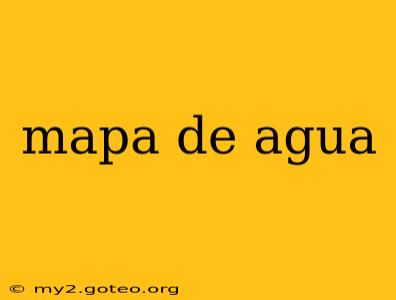Understanding and Utilizing "Mapa de Agua" (Water Map)
The term "mapa de agua" (water map) isn't a standardized term like, say, a topographical map. It's more of a descriptive phrase used in various contexts related to water resources and management. To understand what a "mapa de agua" might represent, we need to explore its potential meanings based on common uses of the phrase. This article will delve into those potential meanings, answering some common questions people might have.
What is a water map used for?
The purpose of a "mapa de agua," or water map, depends entirely on the context. It could represent several things, including:
-
Hydrological Maps: These maps visually depict the distribution of water resources in a given area. This might include rivers, lakes, groundwater sources, and even precipitation patterns. Hydrologists use these to understand water flow, predict floods, and manage water supplies. These are often detailed and technical.
-
Water Quality Maps: These maps focus on the quality of water in different locations. They might show levels of pollution, salinity, or other relevant parameters. Environmental agencies use these for monitoring, protection, and regulation purposes.
-
Irrigation Maps: In agriculture, a water map could show the irrigation systems in use, helping farmers optimize water usage and plan for efficient crop production. These are often linked to Geographic Information Systems (GIS).
-
Water Availability Maps: These maps visualize the availability of water resources over time, potentially showing seasonal variations or long-term trends in water scarcity or abundance. This information is crucial for planning and drought management.
-
Flood Risk Maps: These maps highlight areas at risk of flooding, showing potential floodplains and water levels during flood events. This data helps in urban planning, emergency response, and insurance assessments.
What information does a water map contain?
The specific information contained in a water map varies greatly depending on its purpose. However, common elements include:
- Geographic location: Precise coordinates and boundaries of the area being mapped.
- Water bodies: Representation of rivers, lakes, streams, reservoirs, and other surface water features.
- Groundwater information: Data on groundwater levels, aquifers, and their properties.
- Water quality data: Indicators of water purity, such as salinity, pH levels, or pollutant concentrations.
- Infrastructure: Depiction of dams, canals, pipelines, and other water-related infrastructure.
- Elevation data: Topographic information is often crucial for understanding water flow and accumulation.
How is a water map created?
Water maps are typically created using a combination of techniques:
- Remote sensing: Satellite imagery and aerial photography provide broad-scale views of water bodies and land cover.
- Field surveys: On-the-ground measurements and observations supplement remote sensing data, providing more detailed information.
- GIS technology: Geographic Information Systems are used to integrate and analyze data from various sources, creating interactive and dynamic maps.
- Modeling: Computer models are used to simulate water flow, predict future conditions, and assess the impact of various scenarios.
Where can I find a water map?
The availability of water maps depends on the region and the type of map needed. Many governmental agencies (e.g., environmental protection agencies, water resource departments) provide public access to water-related data and maps on their websites. Other sources include academic institutions, research organizations, and private companies involved in water management. It's often best to conduct a search specific to the region and the type of water map you need. For example, searching for "water quality map [your region]" or "flood risk map [your city]" will yield more precise results.
This comprehensive overview should clarify the multifaceted nature of the term "mapa de agua." Its meaning and application vary depending on the specific context and intended use. Remember to specify your needs when searching for this type of data to find the most relevant and useful information.

